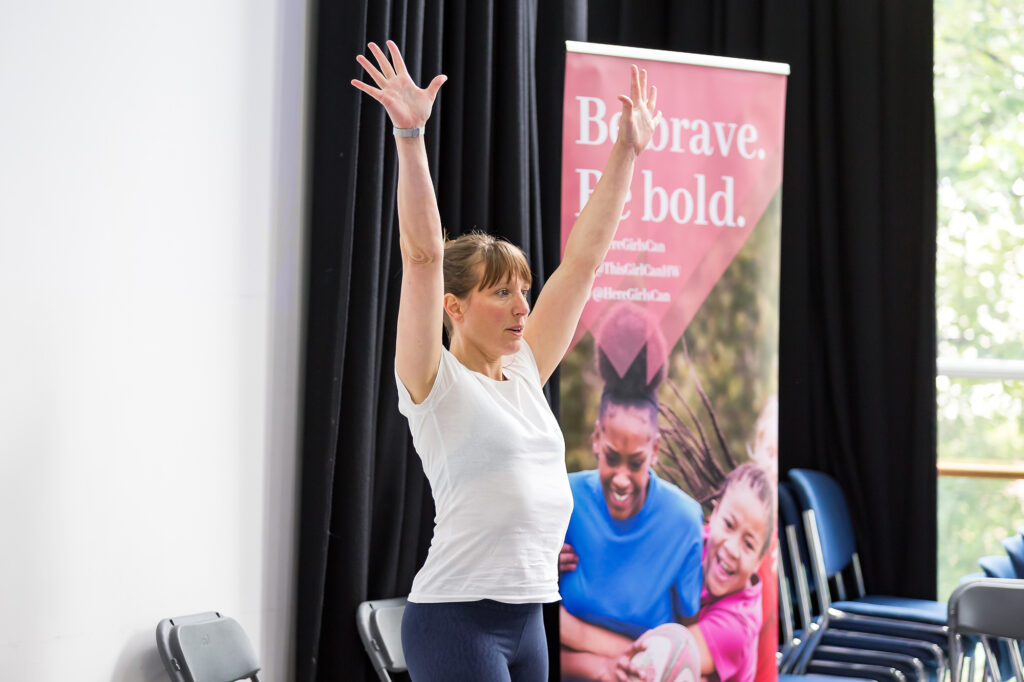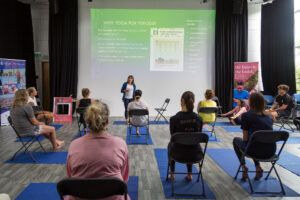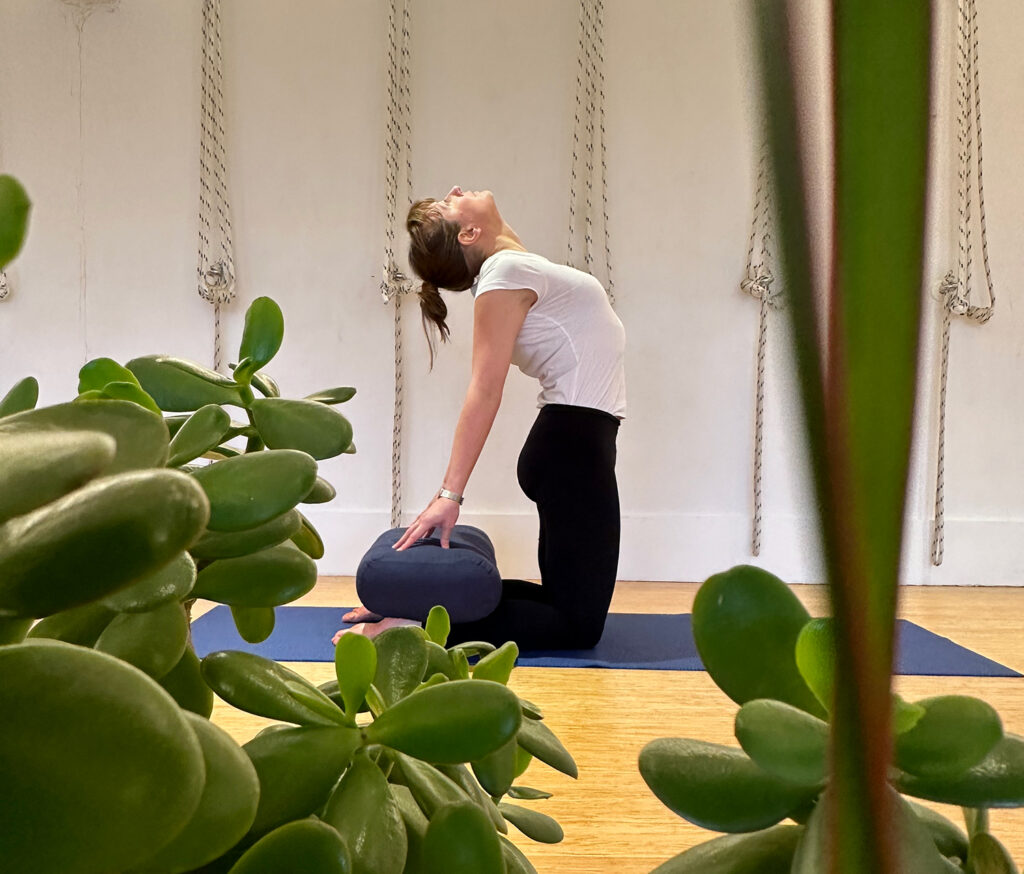and yoga pre- and post-surgery

Jenny-May teaching at Here Girls Can Teacher Conference 2023. Image by capturedbygabi.com
It’s another one of those stories. We’re hearing more of them these days as women find their voice around menstrual health. Years of heavy, painful periods. Dismissal by medical professionals. Useless prescriptions. You know how it goes. (If you don’t want to read another personal account, skip the italics).
I thought my periods were probably heavier and more painful than many other women I knew, but it’s hard to know, right? It’s not like we compare flow. So I did some research. Over 35 mg of blood loss during a period on a regular basis is defined as menorrhagia, or clinically heavy menstrual bleeding. I measured, using a menstrual cup. They have little markers like a measuring jug; 7.5 mg is a full cup. Over several cycles, I was averaging in excess of 180 mg blood loss per period. Each usually lasted more than 7 days on a 23-day cycle. I was bleeding a lot, a lot of the time. The pain was debilitating, like a feeling of being scraped out from the inside along with cramping and excruciating lower back ache. In between, I’d have days of flu-like symptoms (shivering, fever, aching joints, diarrhoea). This continued through my late twenties and thirties, into my forties. Every month, just a few days of feeling well. I treasured those days, but they were always lined with dread of what was coming. When I described the symptoms to my GP, I was told ‘a lot of women have heavy periods. You can try tranexamic acid, that might help reduce the bleeding’.
Tranexamic acid is a blood-clotting drug used to stop trauma patients bleeding out. I should have asked, ‘If a prescription for trauma is required, wouldn’t it be a good idea to find out what’s causing the traumatic symptoms?’ I didn’t ask that, because I’d just been told by a doctor that this was normal. I felt that I was being told not make a fuss. This is just being a woman- get on with it. TA did help, a little, for a few months, but then the periods were back with a vengeance. On my next visit I was advised to have a Mirena coil fitted. Still no investigation into the cause of the symptoms. Still no physical examination. The coil made no difference and everything got worse. I had to plan my whole life around my periods.
Finally, in 2023, I found a large lump in my abdomen. I was put on the ‘fast-track’ and had scans to check for some form of abdominal cancer. Lucky for me, no cancer. A simple ultrasound scan found multiple very large fibroids. Once cancer was eliminated I was told to go away. ‘Lots of women have fibroids. They will shrink once you’ve been through menopause’. So I was back to struggling with increasingly debilitating symptoms. I couldn’t sleep, it hurt to walk, the discomfort was constant, I was anaemic and exhausted, the pain was like being in labour and the bleeding was off the scale- my bathroom looked like a scene from a horror movie and I’d spend some of many wakeful nights mopping up blood. The impact on my relationships and my work was tangible and horrible. Why was it so difficult to get someone to listen? I said to my (male) partner ‘If you turned up at the doctor’s in this much pain and losing this much blood, you’d be rushed straight to hospital for diagnosis and treatment. But because it’s coming out of my vagina, it doesn’t count?’ I ended up in tears in the gynaecologist’s consultation room, begging for a hysterectomy. I didn’t want a womb. I wanted a life.
I definitely consider myself one of the lucky ones. During surgery I was diagnosed with endometriosis in addition to the fibroids, but so far the hysterectomy seems to have cleared up all symptoms. Since surgery, my life is inexpressibly better. I can be present for my family, work and friends in a way that hasn’t been possible for over a decade. I wake up every day grateful for the freedom I’ve been given.

Jenny-May presenting at the HGC Teacher conference 2023. Image: capturedbygabi.com
When the condition was progressing over all those years, I had recourse to a wonderful toolkit in the form of the ‘menstrual’ Iyengar yoga practice. This concentrates on creating space around the abdomen, pelvis and lower back and resting the head. I found it immensely helpful- it was a huge comfort and brought me relief from the suffering. It helped me to rest and to function. But I think as practitioners and teachers of yoga we need to be careful that the practices we engage with and promote are not used as a sticking plaster. Would I have sought medical attention sooner if I hadn’t had the menstrual practice to help me to cope? Quite possibly. This does not detract from the benefits it brought, and turning up to the doctor sooner doesn’t mean that they would have taken any more notice. But it has certainly made me consider how we can and should use the therapeutic application of yoga to relieve symptoms and aid recovery but not as a crutch that could lead to delayed diagnosis.
I took care to make the time and space to allow my body to heal, and it’s been an astounding and inspiring process.
After hysterectomy I was conscientious about the post-surgery recovery period. I took care to make the time and space to allow my body to heal, and it’s been an astounding and inspiring process. These many trillions of cells that collaborate at every moment to form a human life- they want to function well. They want the connections to be working. There’s a kind of self-healing that is available to all of us if we’re able to create the conditions in which it can flourish. For me, that meant surgery followed by calm, quiet, rest and yoga. Post-surgery, I continued to practise every day; at first just a few conscious breaths, then gradually evolving gentle routines that let me find out what was happening, what was possible. It’s an ongoing process. Without doubt, the Iyengar yoga practice I’d established over years was a great help in aiding my recovery; I was able to observe and adapt in response to my changing conditions. This is the magic of the method.

What I’m sharing here in the videos is based on the practises that I found so helpful after laparoscopic hysterectomy. I hope they might help someone else find that path to health and freedom from pain that is so precious. Everyone’s recovery is subjective and personal, so if you’re using these suggestions you must do so with a view to adapting to your own conditions and of course following the advice of your medical team.
In conclusion, I’m very grateful to be free from pain, and am continuing to process the anger I feel around being ignored for so long. I am angry on behalf of all women who have their pain dismissed. Who are routinely gas-lit into believing they don’t deserve proper investigation into their symptoms. A 2023 study found that of over 6.2 million women in the UK who suffer severe menstrual pain, over half found that their healthcare professionals failed to take the problem seriously*. We know that Black and minority ethnic women are more likely to be ignored than white women. All of this has to change, and I welcome the increased media attention this topic is currently demanding. Let’s not allow it to fade. If you are a woman living with pain, it’s unlikely that you will find the energy to raise your voice and shout about it. It’s a head-down, get-on-with-it situation and is how silencing works so effectively. As part of a growing number of women who have experienced this discrimination but are no longer in pain, I’m shouting loudly and energetically for systemic change that ensures equitable access to diagnosis and treatment routes, so that our sisters (and daughters) will not suffer as we have done.
Sequence for Menstruation – Iyengar Yoga Practice



Comments are closed.